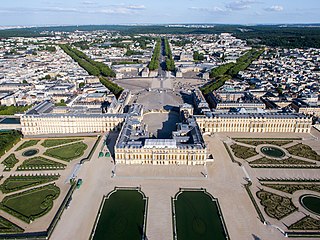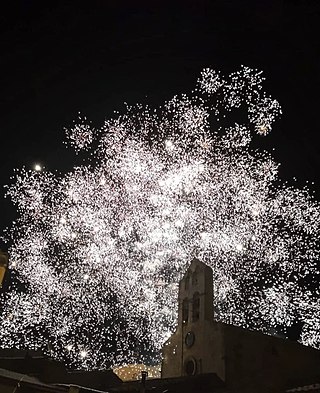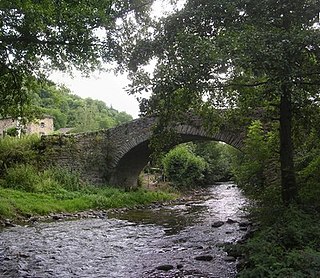
Château de Beurthé or Château de Steinbach is a castle situated in Steinbach, municipality of Gouvy, southeastern Belgium. Its park borders on the small river Steinbach, a tributary of the Ourthe Orientale.

Château de Beurthé or Château de Steinbach is a castle situated in Steinbach, municipality of Gouvy, southeastern Belgium. Its park borders on the small river Steinbach, a tributary of the Ourthe Orientale.
The name of the castle and its owners has changed throughout history. The name "Steinbach" has been spelled Steinbac (1276), Stambaz (1363), Stembasche (1372), Stembaix (1372), Stembay (1395-1580), and Stembaye (1611-1716).
This section needs attention from an expert in Belgium, Luxembourgor Netherlands. The specific problem is: lack of information on local context and history.(October 2020) |
The foundations and the basement of the castle date back to the 11th century and are built with schist stone. The stone-carved escutcheon built into the façade of the castle contains three scallops referring to Steinbach and Limerlé, and three sickles referring to Grumelscheid. [1]
The Steinbach family and dynasty became lords of Rouvroy and Limerlé in 1451 and will keep this title and rule the region until the late 18th century. Alliances were built through marriage and over the years the titles of the lord of Steinbach, Limerlé, Grumelscheid, Aspelt, Bourcy and Longvilly were added to this noble house. As an example a document dated 1578 refers to the marriage of Georges Ramel de Steinbach and Margueritte de Grumelscheid.
During the Spanish reign over what is now known as Belgium and Holland Martin I de Steinbach bought back his castle and his right to rule the region from King Philip IV of Spain. He equally acquired the right to speak justice and the death penalty. On the 1777 Ferraris maps, a gallows can be found close to the castle. The links with the Spanish rulers, however, was still very strong and as such, some revenues of the land would be to the benefit of Isabella of Spain in infinity. The three lions can be found back on the escutcheons of Catherine van der Heyden wife of Martin de Steinbach. The escutcheon of Martin de Steinbach are as mention the three saint James scallops referring to Santiago de Compostela.
In 1802 shortly after the French revolution, Henri de Steinbach buys a Malmedy-based paper mill which the monks of Malmedy had started in 1750. This mill was the base for what was soon to be known as a brand of famous photographic film. The wealth coming from this paper mill allowed the family to maintain their castle. In Malmedy the Villa Lang and Villa Steissel, both national monuments were built by the Steinbach family. The family owned the Castle of Liherin and the castle du Mesnil both located in Steinbach as well as 4.000 hectares of farmland and woods.
During the Second World War the castle played a significant role in the Battle of the Bulge. It was beside a temporary headquarter for Léon Degrelle and his government a field hospital for both the German and US army.
The castle stayed in the hands of descendants of the Steinbach family until 2014 when it was sold to its current owners who used it as a second residence.
The castle has a very Austrian style architecture which can be explained by the fact that the castle was erected after a devastating fire in 1750 which burnt most of the existing castle to ruins. The architect was Albert Starck from Austria who during the Austrian reign of this part of Europe built several important buildings (today national monuments) in this area such as the rectory of Bovingy. The castle itself is built in 1.5-meter thick schist stone walls. The wings were added in the early 19th century and served as farmhouses. The farm was reachable from the outside leaving all privacy to the castle. The interior floors are built in schist stone and the style is Louis XV. The main entrance to the castle is carved out of Recht stone and contains the escutcheon of the Beurthé. The farms also contain a wood oven dating back to the 16th century. The oven is still in regular use today. On the top of the tower, one can see elephant shaped flags bearing the family escutcheons and building date. All buildings on this site are protected as national monuments.

A château is a manor house, or palace, or residence of the lord of the manor, or a fine country house of nobility or gentry, with or without fortifications, originally, and still most frequently, in French-speaking regions.

Amblie is a former commune in the Calvados department in the Normandy region of northwestern France. On 1 January 2017, it was merged into the new commune Ponts sur Seulles.

Franchimont Castle is a medieval castle in the municipality of Theux, Liège Province, Wallonia, Belgium. It sits at the western end of a small hill 2 kilometres (1.2 mi) south of the village of Theux, a sub-municipality.

Vinaixa is a municipality in the region of Les Garrigues, in the province of Lleida, Catalonia, Spain.

The Château de Châteaudun is a castle located in the town of Châteaudun in the French department of Eure-et-Loir.

The Château of Seneffe or Château de Seneffe is an 18th-century château located in the municipality of Seneffe in the province of Hainaut, Wallonia, Belgium. The château is property of the French Community of Belgium and serves as the "Centre de l'orfèvrerie de la communauté française" which displays a collection of antique silverware.

Mirwart Castle is situated in Mirwart in Saint-Hubert, in the province of Luxembourg, Wallonia, Belgium.

Ambrugeat is a commune in the Corrèze department in the Nouvelle-Aquitaine region of central France.

Sévérac-le-Château is a former commune in the Aveyron department in Occitania, southern France. On 1 January 2016, it was merged into the new commune of Sévérac-d'Aveyron.

Auriac-l'Église is a commune in the Cantal department in the Auvergne region of south-central France.

Grivesnes is a commune in the Somme department in Hauts-de-France in northern France.

The Château de Vayres is a medieval castle, located on the banks of the Dordogne River, located in the commune of Vayres, in the Gironde Department of France, near the city of Bordeaux. The château de Vayres was rebuilt during the Renaissance, and again in 1700. It is classified as an official historical landmark of France, and the gardens are listed as among the Notable Gardens of France by the Committee of Parks and Gardens of the French Ministry of Culture,

The Princely Abbey of Stavelot-Malmedy, also Principality of Stavelot-Malmedy, sometimes known with its German name Stablo, was an ecclesiastical principality of the Holy Roman Empire. Princely power was exercised by the Benedictine abbot of the imperial double monastery of Stavelot and Malmedy, founded in 651. Along with the Duchy of Bouillon and the Prince-Bishopric of Liège, it was one of only three principalities of the Southern Netherlands that were never part of the Spanish Netherlands, later the Austrian Netherlands, which after 1500 were assigned to the Burgundian Circle while the principalities were assigned to the Lower Rhenish Imperial Circle.
Cartier Castle is a château in Marchienne-au-Pont, a district of Charleroi, in the province of Hainaut, Wallonia, Belgium.
Morialmé Castle is a château in Morialmé, part of the municipality of Florennes, province of Namur, Wallonia, Belgium.

A rock castle is a type of medieval castle that directly incorporates natural rock outcrops into its defences to such an extent that the rock formations define the structure of the castle. Topographically, rock castles are classified as hill castles.

Marschlins Castle is a castle in the village of Igis of the municipality of Landquart of the Canton of Graubünden in Switzerland. It is a Swiss heritage site of national significance.

The Château de Châteaubriant is a medieval castle strongly modified during the Renaissance, located in the commune of Châteaubriant in the Loire-Atlantique département of France. The original castle was founded in the 11th century on the eastern border of Brittany and, such as the fortresses in Vitré, Fougères, Ancenis and Clisson, it was defending the duchy against Anjou and the Kingdom of France.

Ouren is a village in Belgium with a population of 129 inhabitants. Ouren is a part of the municipality of Burg-Reuland and thus belongs to the German-speaking Community of Belgium.

The Belvédère Château is a residence of the Belgian royal family in Laeken, Brussels, which currently houses King Albert II and his wife, Queen Paola. It is near the Royal Palace of Laeken, the official residence of the King and Queen of the Belgians. Another nearby residence, the Villa Schonenberg, is home to Princess Astrid, the sister of the current king, Philippe.
Les communes luxembourgeoises " d'Emile Tandel - 1889-1894 Royal decree Belgium classement monument 28/7/1976 royal decree Belgium classement monument 3/7/1989 Archives Arlon et Luxembourg